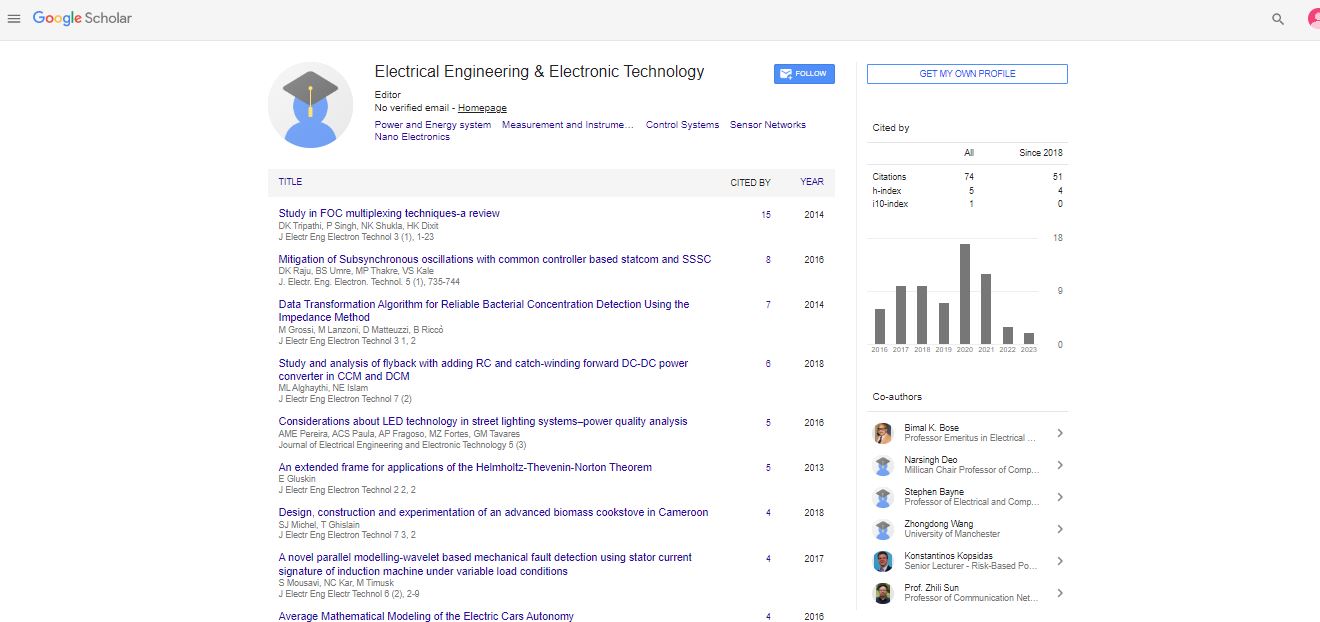Editorial, J Electr Eng Electron Technol Vol: 14 Issue: -1
Load Flow Analysis: Ensuring Efficient Power System Operation
Croughan S*
Department of Microelectronics, Harvard University, United States
- *Corresponding Author:
- Croughan S
Department of Microelectronics, Harvard University, United States
E-mail: s924@gmail.com
Received: 01-Jan-2025, Manuscript No. jeeet-25-170061; Editor assigned: 4-Jan-2025, Pre-QC No. jeeet-25-170061 (PQ); Reviewed: 18-Jan-2025, QC No. jeeet-25-170061; Revised: 25-Jan-2025, Manuscript No. jeeet-25-170061 (R); Published: 30-Jan-2025, DOI: 10.4172/2325-9838.1000992
Citation: Croughan S (2025) Load Flow Analysis: Ensuring Efficient Power System Operation. J Electr Eng Electron Technol 14: 992
Abstract
Introduction
Load flow analysis, also known as power flow analysis, is a fundamental study in electrical power engineering that determines the voltage, current, active power, and reactive power throughout an electrical power system under steady-state conditions. It is crucial for the planning, operation, and optimization of power systems, ensuring efficient and reliable delivery of electricity. As modern power systems become more complex with the integration of renewable energy, distributed generation, and varying loads, accurate load flow analysis is more important than ever [1].
Discussion
The primary objective of load flow analysis is to compute the steady-state operating characteristics of an electrical network. This involves calculating the voltage magnitude and phase angle at each bus (node), as well as the power flowing through transmission lines and transformers. These parameters help engineers understand system performance, identify potential issues, and plan upgrades or expansions [2].
Load flow studies use mathematical models of power systems, which include buses (nodes where power is injected or drawn), generators, loads, transmission lines, transformers, and other components. Each bus is classified into one of three types based on the known and unknown variables:
- Slack Bus: Also called the reference bus, it balances the active and reactive power in the system. Its voltage magnitude and angle are fixed, while power outputs adjust to meet system demand [3].
- PV Bus: Represents generator buses where active power and voltage magnitude are specified, but voltage angle and reactive power are unknown.
- PQ Bus: Represents load buses where active and reactive power demands are specified, but voltage magnitude and angle are unknown [4].
The load flow problem involves solving a set of nonlinear algebraic equations derived from Kirchhoffâ??s laws. Due to the complexity, numerical methods are used, with the Gauss-Seidel, Newton-Raphson, and Fast Decoupled Load Flow methods being the most popular.
The Newton-Raphson method is widely favored for its fast convergence and accuracy, even for large systems. It uses iterative linear approximations to solve the nonlinear equations efficiently. The Fast Decoupled method simplifies computations further, making it suitable for real-time applications, though it is less accurate under certain conditions [5].
Load flow analysis helps identify several critical issues in power systems:
- Voltage violations where bus voltages deviate beyond acceptable limits.
- Overloading of transmission lines or transformers that can lead to failures.
- Power losses and inefficiencies within the system.
- System stability under various operating scenarios.
By simulating different load levels, generation dispatches, and contingency scenarios, engineers can plan preventive measures, optimize generation schedules, and enhance system reliability.
Conclusion
Load flow analysis is a vital tool in power system engineering, enabling efficient operation, planning, and control of electrical networks. It provides detailed insights into the distribution of voltages, currents, and power flows, helping prevent system failures and improve performance. As the power grid evolves with the integration of renewable energy and smart technologies, load flow analysis will continue to be indispensable for ensuring stability and reliability. Mastery of load flow techniques is essential for engineers aiming to design and operate modern, resilient power systems.
References
- de Jonge P, Wardenaar KJ, Hoenders H, Evans-Lacko S, Kovess-Masfety V, et al (2018). Complementary and alternative medicine contacts by persons with mental disorders in 25 countries: results from the world mental health surveys. Epidemiol Psychiatr Sci. 27: 552-567.
- Park C (2013). Mind-body CAM interventions: Current status and considerations for integration into clinical health psychology. J Clin Psychol. 69: 45-63.
- Sarris J, Glick R, Hoenders R, Duffy J, Lake J, et al (2014). Integrative mental healthcare White paper: establishing a new paradigm through research, education, and clinical guidelines. Adv Int Med. 1: 9-16.
- Liem A, Rahmawati KD (2017). The meaning of complementary, alternative and traditional medicine among the Indonesian psychology community: a pilot study. J Int Med. 15: 288-294.
- Vohra S, Feldman K, Johnston B, Waters K, Boon H, et al (2005). Integrating complementary and alternative medicine into academic medical centers: experience and perceptions of nine leading centers in North America. BMC Health Serv Res. 5: 78-84.
Indexed at, Google scholar, Cross ref
Indexed at, Google scholar, Cross ref
Indexed at, Google scholar, Cross ref
Indexed at, Google scholar, Cross ref
 Spanish
Spanish  Chinese
Chinese  Russian
Russian  German
German  French
French  Japanese
Japanese  Portuguese
Portuguese  Hindi
Hindi 
